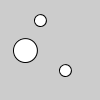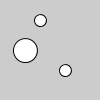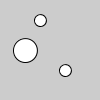| Name | sub() |
||||||||||||||||||
|---|---|---|---|---|---|---|---|---|---|---|---|---|---|---|---|---|---|---|---|
| Examples |

v1 = PVector(40, 20, 0) v2 = PVector(65, 70, 0) ellipse(v1.x, v1.y, 12, 12) ellipse(v2.x, v2.y, 12, 12) v2.sub(v1) ellipse(v2.x, v2.y, 24, 24) 
v = PVector(65, 70, 0) ellipse(v.x, v.y, 12, 12) ellipse(40, 20, 12, 12) v.sub(40, 20, 0) ellipse(v.x, v.y, 24, 24) 
v1 = PVector(65, 70, 0) v2 = PVector(40, 20, 0) ellipse(v1.x, v1.y, 12, 12) ellipse(v2.x, v2.y, 12, 12) v3 = PVector.sub(v1, v2) ellipse(v3.x, v3.y, 24, 24) | ||||||||||||||||||
| Description | Subtracts x, y, and z components from a vector, subtracts one vector from another, or subtracts two independent vectors. The version of the method that substracts two vectors is a static method and returns a PVector, the others have no return value -- they act directly on the vector. See the examples for more context. In all cases, the second vector (v2) is subtracted from the first (v1), resulting in v1-v2. | ||||||||||||||||||
| Syntax | .sub(v) .sub(x, y, z) .sub(v1, v2) .sub(v1, v2, target) | ||||||||||||||||||
| Parameters |
|
Updated on Tue Feb 27 14:07:12 2024.
If you see any errors or have comments, please let us know.

This work is licensed under a Creative Commons Attribution-NonCommercial-ShareAlike 4.0 International License